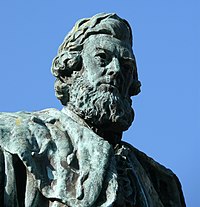William Chambers (publisher)
|
The Right Honourable William Chambers of Glenormiston |
|
|---|---|

Statue erected in memory of William Chambers of Glenormiston. It faces the National Museum of Scotland in Chambers Street, Edinburgh.
|
|
| Lord Provost of Edinburgh | |
|
In office 1865–1869 |
|
| Monarch | Queen Victoria |
| Preceded by | Charles Lawson of Borthwick Hall |
| Succeeded by | William Law |
| Personal details | |
| Born |
16 April 1800 Peebles, United Kingdom |
| Died | 20 May 1883 |
| Nationality | British |
William Chambers of Glenormiston or William Chambers FRSE (16 April 1800 – 20 May 1883) was a Scottish publisher and politician, the brother (and business partner) of Robert Chambers. The brothers were influential in the mid-19th century, in both scientific and political circles.
Chambers was born in Peebles and moved to Edinburgh in 1814 to work in the book-selling trade and soon branched out into printing. He opened his own bookshop in 1819 on Broughton Street, a historical street absorbed by Edinburgh's New Town. and founded the publishing firm of W. & R. Chambers Publishers in 1832. He was a keen advocate of popular education and his firm was a pioneer in the use of industrial technologies of publishing to make print available cheaply. With his younger brother, Robert Chambers, he produced books and periodicals of Scottish interest, such as Gazetteer of Scotland. They also made money in promulgating the many new science discoveries as the modern world emerged from prior modes of thinking in such periodicals as the Edinburgh Journal (see below). Their publishing business prospered, and in 1859 William founded a museum and art gallery in Peebles. The brothers collaborated on the publication of Chambers Encyclopaedia between 1860 and 1868.
He was elected a Fellow of the Royal Society of Edinburgh in 1860, his proposer being John Shank More. His address was then given as 13 Chester Street, a large townhouse in Edinburgh's west end.
As Lord Provost of Edinburgh from 1865 to 1869, Chambers was responsible for the restoration of St Giles Cathedral and other major town planning exercises, including the creation of Jeffrey Street, St Marys Street and Blackfriars Street. These streets were all created under the City Improvement Act of 1866, including one named in his memory: (Chambers Street) and here in its centre stands a statue to him, by local sculptor John Rhind with low-relief copper panels on the base by William Shirreffs.
...
Wikipedia
